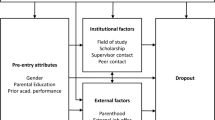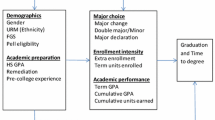Abstract
Doctoral programs have high dropout rates of 43% representing the highest among all post-baccalaureate programs. Cross sectional studies of doctoral students’ retention have showed the importance of financial aid in predicting degree completion. These studies however, do not estimate the labor market’s effect on doctoral student retention and neglect the longitudinal nature of doctoral study and the multiple requirements that make doctoral education a three-stage process. This research study examines the effect of various factors, including financial aid and labor market conditions, on the likelihood that doctoral students will complete the three stages of doctoral education: transition, development, and research. The results show that although financial aid as a whole is important, the type of financial aid received is even more significant and has differential impacts on doctoral students’ retention at each stage. The study concludes that research assistantships have the highest likelihood of degree completion compared to students with other forms of financial support. Labor market conditions are also an important factor affecting doctoral student retention with higher expected earnings motivating doctoral students in the later part of their programs to complete their degrees.






Similar content being viewed by others
References
Allison, P. D. (2010). Survival analysis using the SAS system: A practical guide. Cary, NC: SAS Publishing.
Ampaw, F. (2010,). The effect of labor market conditions and financial aid packages on doctoral students retention. Unpublished dissertation, North Carolina State University.
Ampaw, F., & Jaeger, A. J. (2010, May). The effect of labor market conditions and financial aid packages on degree completion of doctoral students. Paper presented at the annual meeting of Association for Institutional Research, Chicago.
Anderson, B. (1990). Minorities and mathematics: The new frontier and challenge of the nineties. Journal of Negro Education, 59(3), 260–272. Retrieved from http://www.jstor.org/stable/2295562.
Andrieu, S. C., & St. John, E. P. (1993). The influence of prices on graduate student persistence. Research in Higher Education, 34(4), 399–425. doi:10.1007/BF00991852.
Aslanbeigui, N., & Montecinos, V. (1998). Foreign students in US doctoral programs. Journal of Economic Perspectives, 12, 171–182. Retrieved from http://www.jstor.org/stable/2647038.
Association of American Medical Colleges (AAMC). (2007). Medical school graduation and attrition rates. Analysis in Brief, 7(2), 1–2. Retrieved from http://www.aamc.org/data/aib/aibissues/aibvol7_no2.pdf.
Becker, G. S. (1962). Investment in human capital: A theoretical analysis. The Journal of Political Economy, 70(5), 9–49. doi:10.1086/258724.
Becker, G. S. (1964). Human capital: A theoretical and empirical analysis, with special reference to education. New York: National Bureau of Economic Research.
Berg, H. M., & Ferber, M. A. (1983). Men and women graduate students: Who succeeds and why? Journal of Higher Education, 54(6), 629–648. Retrieved from http://www.jstor.org/stable/1981934.
Blossfeld, H. P., & Rohwer, G. (2002). Techniques of event history modeling: New approaches to causal analysis. Hillsdale, NJ: Erlbaum.
Bowen, W. G., & Rudenstine, N. L. (1992). In pursuit of the PhD. Princeton, NJ: Princeton University Press.
Chen, R. (2007) Socioeconomic and racial/ethnic gaps in student dropout risks: A longitudinal model to examine the differential effects of financial aid. Unpublished doctoral dissertation, University of Michigan, Ann Arbor, MI.
Council of Graduate Schools (CGS). (2008). Ph.D. completion and attrition: Analysis of baseline demographic data from the Ph.D. completion project. Washington, DC: Author.
Cox, D. R. (1972). Regression models and life tables (with discussion). Journal of the Royal Statistical Society, Series B, 34(2), 187–220. Retrieved from http://www.jstor.org/stable/2985181.
DesJardins, S. L. (2003). Event history methods: Conceptual issues and application to student departure from college. In J. C. Smart (Ed.), Higher education: Handbook of theory and research (Vol. XVIII, pp. 421–471). Boston: Kluwer.
DesJardins, S. L., Ahlburg, D. A., & McCall, B. P. (1999). An event history model of student departure. Economics of Education Review, 18(3), 375–390. doi:10.1016/S0272-7757(98)00049-1.
DesJardins, S. L., Ahlburg, D. A., & McCall, B. P. (2002). Simulating the longitudinal effects of changes in financial aid on student departure from college. Journal of Human Resources, 37(3), 653–679. doi:10.2307/3069685.
Dodson, T. F., & Webb, A. L. (2004). Why do residents leave general surgery? The hidden problem in today’s program. Current Surgery, 62(1), 128–131. doi:10.1016/j.cursur.2004.07.009.
Educational Testing Service (ETS). (2003). Graduate record examination 2003–04: Guide to the use of scores. Princeton, NJ: Educational Testing Service.
Ehrenberg, R. G. (1991). Academic labor supply. In C. T. Clotfelter, R. G. Ehrenberg, M. Getz, & J. J. Siegfried (Eds.), Economic challenges in higher education (pp. 143–260). Chicago: University of Chicago Press.
Ehrenberg, R. G., & Mavros, P. (1995). Do doctoral students’ financial support patterns affect their times-to-degree and completion probabilities. The Journal of Human Resources, 30(3), 581–609. doi:10.2307/146036.
Ellis, E. M. (2001). The impact of race and gender on graduate school socialization, satisfaction with doctoral study, and commitment to degree completion. The Western Journal of Black Studies, 25(1), 30–45.
Gail, M. H., Wieand, S., & Piantadosi, S. (1984). Biased estimates of treatment effect in randomized experiments with nonlinear regressions and omitted covariates. Biometrika, 71, 431–444. Retrieved from http://www.jstor.org/stable/2336553.
Gay, G. (2004). Navigating marginality en route to the professoriate: Graduate students of color learning and living in academia. International Journal of Qualitative Studies in Education, 17(2), 265–287. doi:10.1080/09518390310001653907.
Gillingham, L., Seneca, J. J., & Taussig, M. K. (1991). The determinants of progress to the doctoral degree. Research in Higher Education, 32(4), 449–468. doi:10.1007/BF00992186.
Girves, J. E., & Wemmerus, V. (1988). Developing models of graduate student degree progress. Journal of Higher Education, 59(2), 163–189. doi:10.2307/1981691.
Gross, P. K. (2008). Promoting or perturbing access: An event history analysis of the effects of financial aid on Latino students’ educational attainment. Unpublished doctoral dissertation, Indiana University, Bloomington.
Haley, K. J., & Jaeger, A. J., & Levin, J. (2010). Not all going in the same direction: The effects of social identity on graduate student career choices. Paper presented at the American Educational Research Association Conference, Denver, CO.
Ishitani, T. T., & DesJardins, S. L. (2002). A longitudinal investigation of dropout from colleges in the United States. Journal of College Student Retention, 4(2), 173–201. doi:10.2190/V4EN-NW42-742Q-2NTL.
Jaeger, A. J., Austin, A., Levin, J., Haley, K., Cox, E., & Ampaw, F. (2009, November). A mysterious and sometimes perilous path to the professoriate: Graduate students of color in the research university. Symposium presented at the Association for Study of Higher Education Conference, Vancouver, Canada.
Johnson, B. (2001). Toward a new classification of nonexperimental quantitative research. Educational Researcher, 30(2), 3. doi:10.3102/0013189X030002003.
Kane, T. J. (1999). The price of admission: Rethinking how Americans pay for college. Washington, DC: The Brookings Institution.
Lott, J. L., Gardener, S., & Powers, D. A. (2009). Doctoral student attrition in the STEM fields: An exploratory event history analysis. Journal of College Student Retention, 11(2), 247–266.
Lovitts, B. E. (2001). Leaving the ivory tower: The causes and consequences of departure from doctoral study. Lanham, MA: Rowman & Littlefield Publishers.
McPherson, M. S., & Schapiro, M. O. (1991). Keeping college affordable. Washington, DC: The Brookings Institution.
Mood, C. (2010). Logistic Regression: Why we cannot do what we think we can do, and what we can do about it. European Sociological Review, 26(1), 67–82.
Morelon-Quainoo C. L., Johnson S. D., Winkle-Wagner, R., Kuykendall, J. A., Ingram, T. N. … Santiague, L. (2009). The advanced-degree pipeline for graduate and professional students of color: issues of access and choice. In M. F. Howard-Hamilton, C. L. Morelon-Quainoo, S. D. Johnson, R. Winkle-Wagner, & L. Santiague (Eds.), Standing on the outside looking in: underrepresented students’ experiences in advanced degree programs (pp. 5–24). Sterling, VA: Stylus.
Nerad, M. & Cerny, J. (1991). From facts to action: Expanding the educational role of the graduate division. CGS Communicator, Special Edition, 1–12.
Nyquist, J. D. (2002). The PhD: A tapestry of change for the 21st century. Change, 34, 12–20.
Ott, M. D., Markewich, T. S., & Ochsner, N. L. (1984). Logit analysis of graduate student retention. Research in Higher Education, 21, 439–460. doi:10.1007/BF00992636.
Pascarella, E. T., & Terenzini, P. (1991). How college affects students. San Francisco: Jossey-Bass.
Paulsen, M. B. (1998). Recent research on the economics of attending college: Returns on investment and responsiveness to price. Research in Higher Education, 39(4), 471–489. doi:10.1023/A:1018793421038.
Paulsen, M. B. (2001). The economics of human capital and investment in higher education. In M. B. Paulsen & J. C. Smart (Eds.), The finance of higher education: Theory, research, policy & practice (pp. 55–94). New York: Agathon.
Pyke, S. W., & Sheridan, P. M. (1993). Logistic regression analysis of graduate student retention. Canadian Journal of Higher Education, 23, 44–64.
Schoenfeld, D. (1982). Partial residuals for the proportional hazards regression model. Biometrika, 69, 239–241. doi:10.1093/biomet/69.1.239.
St. John, E. P. (1990). Price response in persistence decisions: An analysis of the High School and Beyond Senior Cohort. Research in Higher Education, 31(4), 387–403. doi:10.1007/BF00992274.
Stiles, J. E. (2003). The hazard of success: A longitudinal study of time to degree among doctoral students using discrete-time survival analysis. Unpublished doctoral dissertation, Harvard University, Boston.
Stolzenberg, E. B. (2006). The dynamics of the doctoral student–faculty advising relationship: A study across academic fields. Unpublished dissertation, University of California, Los Angeles.
Tinto, V. (1975). Dropout from higher education: A theoretical synthesis of recent research. Review of Educational Research, 45, 89–125. doi:10.2307/1170024.
Tinto, V. (1993). Leaving college: Rethinking the causes and cures of student attrition (2nd ed.). Chicago: University of Chicago Press.
Van Zanten, M., Boulet, J. R., McKinley, D., & Whelan, G. P. (2002). Attrition rates of residents in postgraduate training programs. Teaching and Learning in Medicine, 14(3), 175–177. doi:10.1207/S15328015TLM1403_7.
Williams June, A. (2011, May 15). Universities turn to graduate students to clear course bottlenecks. The Chronicle of Higher Education. Retreived from http://chronicle.com/article/Grad-Students-Take-the-Podium/127542.
Author information
Authors and Affiliations
Corresponding author
Rights and permissions
About this article
Cite this article
Ampaw, F.D., Jaeger, A.J. Completing the Three Stages of Doctoral Education: An Event History Analysis. Res High Educ 53, 640–660 (2012). https://doi.org/10.1007/s11162-011-9250-3
Received:
Published:
Issue Date:
DOI: https://doi.org/10.1007/s11162-011-9250-3




